 Since 2019, UK personal taxes (income tax and national insurance) have been increasing as a proportion of incomes and total tax revenues have been increasing as a proportion of GDP. However, in his Autumn Statement of 22 November, the Chancellor, Jeremy Hunt, announced a 2 percentage point cut in the national insurance rate for employees from 12% to 10%. The government hailed this as a significant tax cut. But, despite this, taxes are set to continue increasing. According to the Office for Budget Responsibility (OBR), from 2019/20 to 2028/29, taxes will have increased by 4.5 per cent of GDP (see chart below), raising an extra £44.6 billion per year by 2028/29. One third of this is the result of ‘fiscal drag’ from the freezing of tax thresholds.
Since 2019, UK personal taxes (income tax and national insurance) have been increasing as a proportion of incomes and total tax revenues have been increasing as a proportion of GDP. However, in his Autumn Statement of 22 November, the Chancellor, Jeremy Hunt, announced a 2 percentage point cut in the national insurance rate for employees from 12% to 10%. The government hailed this as a significant tax cut. But, despite this, taxes are set to continue increasing. According to the Office for Budget Responsibility (OBR), from 2019/20 to 2028/29, taxes will have increased by 4.5 per cent of GDP (see chart below), raising an extra £44.6 billion per year by 2028/29. One third of this is the result of ‘fiscal drag’ from the freezing of tax thresholds.
According to the OBR
Fiscal drag is the process by which faster growth in earnings than in income tax thresholds results in more people being subject to income tax and more of their income being subject to higher tax rates, both of which raise the average tax rate on total incomes.
Income tax thresholds have been unchanged for the past three years and the current plan is that they will remain frozen until at least 2027/28. This is illustrated in the following table.

If there were no inflation, fiscal drag would still apply if real incomes rose. In other words, people would be paying a higher average rate of tax. Part of the reason is that some people on low incomes would be dragged into paying tax for the first time and more people would be paying taxes at higher rates. Even in the case of people whose income rise did not pull them into a higher tax bracket (i.e. they were paying the same marginal rate of tax), they would still be paying a higher average rate of tax as the personal allowance would account for a smaller proportion of their income.
Inflation compounds this effect. Tax bands are in nominal not real terms. Assume that real incomes stay the same and that tax bands are frozen. Nominal incomes will rise by the rate of inflation and thus fiscal drag will occur: the real value of the personal allowance will fall and a higher proportion of incomes will be paid at higher rates. Since 2021, some 2.2 million workers, who previously paid no income taxes as their incomes were below the personal allowance, are now paying tax on some of their wages at the 20% rate. A further 1.6 million workers have moved to the higher tax bracket with a marginal rate of 40%.
 The net effect is that, although national insurance rates have been cut by 2 percentage points, the tax burden will continue rising. The OBR estimates that by 2027/28, tax revenues will be 37.4% of GDP; they were 33.1% in 2019/20. This is illustrated in the chart (click here for a PowerPoint).
The net effect is that, although national insurance rates have been cut by 2 percentage points, the tax burden will continue rising. The OBR estimates that by 2027/28, tax revenues will be 37.4% of GDP; they were 33.1% in 2019/20. This is illustrated in the chart (click here for a PowerPoint).
Much of this rise will be the result of fiscal drag. According to the OBR, fiscal drag from freezing personal allowances, even after the cut in national insurance rates, will raise an extra £42.9 billion per year by 2027/28. This would be equivalent of the amount raised by a rise in national insurance rates of 10 percentage points. By comparison, the total cost to the government of the furlough scheme during the pandemic was £70 billion. For further analysis by the OBR of the magnitude of fiscal drag, see Box 3.1 (p 69) in the November 2023 edition of its Economic and fiscal outlook.
Political choices
 Support measures during the pandemic and its aftermath and subsidies for energy bills have led to a rise in government debt. This has put a burden on public finances, compounded by sluggish growth and higher interest rates increasing the cost of servicing government debt. This leaves the government (and future governments) in a dilemma. It must either allow fiscal drag to take place by not raising allowances or even raise tax rates, cut government expenditure or increase borrowing; or it must try to stimulate economic growth to provide a larger tax base; or it must do some combination of all of these. These are not easy choices. Higher economic growth would be the best solution for the government, but it is difficult for governments to achieve. Spending on infrastructure, which would support growth, is planned to be cut in an attempt to reduce borrowing. According to the OBR, under current government plans, public-sector net investment is set to decline from 2.6% of GDP in 2023/24 to 1.8% by 2028/29.
Support measures during the pandemic and its aftermath and subsidies for energy bills have led to a rise in government debt. This has put a burden on public finances, compounded by sluggish growth and higher interest rates increasing the cost of servicing government debt. This leaves the government (and future governments) in a dilemma. It must either allow fiscal drag to take place by not raising allowances or even raise tax rates, cut government expenditure or increase borrowing; or it must try to stimulate economic growth to provide a larger tax base; or it must do some combination of all of these. These are not easy choices. Higher economic growth would be the best solution for the government, but it is difficult for governments to achieve. Spending on infrastructure, which would support growth, is planned to be cut in an attempt to reduce borrowing. According to the OBR, under current government plans, public-sector net investment is set to decline from 2.6% of GDP in 2023/24 to 1.8% by 2028/29.
The government is attempting to achieve growth by market-orientated supply-side measures, such as making permanent the current 100% corporation tax allowance for investment. Other measures include streamlining the planning system for commercial projects, a business rates support package for small businesses and targeted government support for specific sectors, such as digital technology. Critics argue that this will not be sufficient to offset the decline in public investment and renew crumbling infrastructure.
To support public finances, the government is using a combination of higher taxation, largely through fiscal drag, and cuts in government expenditure (from 44.8% of GDP in 2023/24 to a planned 42.7% by 2028/29). If the government succeeds in doing this, the OBR forecasts that public-sector net borrowing will fall from 4.5% of GDP in 2023/24 to 1.1% by 2028/29. But higher taxes and squeezed public expenditure will make many people feel worse off, especially those that rely on public services.
Videos
 Fiscal drag
Fiscal dragSky News Politics Hub on X, Sophy Ridge (22/11/23)
 Fiscal drag
Fiscal dragSky News Politics Hub on X, Beth Rigby (22/11/23)
Articles
- Autumn Statement 2023 response
IFS, Stuart Adam, Bee Boileau, Isaac Delestre, Carl Emmerson, Paul Johnson, Robert Joyce, Martin Mikloš, Helen Miller, David Phillips, Sam Ray-Chaudhuri, Isabel Stockton Tom Waters, Tom Wernham and Ben Zaranko (22/11/23)
- Autumn Statement: Jeremy Hunt cuts National Insurance but tax burden still rises
BBC News, Brian Wheeler (23/11/23)
- The hidden tax rise in the Autumn Statement
BBC News, Michael Race (23/11/23)
- How is National Insurance changing and what is income tax?
BBC News (23/11/23)
- UK income tax: how fiscal drag leads to people falling into higher rates
The Guardian, Antonio Voce and Ashley Kirk (22/11/23)
- Will I be pulled into a higher tax band? How ‘fiscal drag’ affects your pay
i News, Alex Dakers (23/11/23)
- Fiscal drag could cost high earners £4,000 by 2027
MoneyWeek, Marc Shoffman (16/11/23)
- Why the UK government’s tax cuts still leave workers worse off
CNBC, Elliot Smith (23/11/23)
- National insurance cuts swamped by stealth tax rise, says fiscal watchdog
Financial Times, Emma Agyemang (22/11/23)
- Frozen income tax bands eat into benefits of NI cut, say experts
FT Adviser, Tara O’Connor (23/11/23)
- Jeremy Hunt’s fiscal fudge
Financial Times editorial (22/11/23)
Report and data from the OBR
Questions
- Would fiscal drag occur with frozen nominal tax bands if there were zero real growth in incomes? Explain.
- Examine the arguments for continuing to borrow to fund a Budget deficit over a number of years.
- When interest rates rise, how much does this affect the cost of servicing public-sector debt? Why is the effect likely to be greater in the long run than in the short run?
- If the government decides that it wishes to increase tax revenues as a proportion of GDP (for example, to fund increased government expenditure on infrastructure and socially desirable projects and benefits), examine the arguments for increasing personal allowances and tax bands in line with inflation but raising the rates of income tax in order to raise sufficient revenue?
- Distinguish between market-orientated and interventionist supply-side policies? Why do political parties differ in their approaches to supply-side policy?
 In his blog, The bond roller coaster, John looks at the pricing of government bonds and details how, in recent times, governments wishing to borrow by issuing new bonds are having to offer higher coupon rates to attract investors. The interest rate hikes by central banks in response to global-wide inflationary pressures have therefore spilt over into bond markets. Though this evidences the ‘pass through’ of central bank interest rate increases to the general structure of interest rates, it does, however, pose significant costs for governments as they seek to finance future budgetary deficits or refinance existing debts coming up to maturity.
In his blog, The bond roller coaster, John looks at the pricing of government bonds and details how, in recent times, governments wishing to borrow by issuing new bonds are having to offer higher coupon rates to attract investors. The interest rate hikes by central banks in response to global-wide inflationary pressures have therefore spilt over into bond markets. Though this evidences the ‘pass through’ of central bank interest rate increases to the general structure of interest rates, it does, however, pose significant costs for governments as they seek to finance future budgetary deficits or refinance existing debts coming up to maturity.
The Autumn Statement in the UK is scheduled to be made on 22 November. This, as well as providing an update on the economy and the public finances, is likely to include a number of fiscal proposals. It is thus timely to remind ourselves of the size of recent discretionary fiscal measures and their potential impact on the sustainability of the public finances. In this first of two blogs, we consider the former: the magnitude of recent discretionary fiscal policy changes.
First, it is important to define what we mean by discretionary fiscal policy. It refers to deliberate changes in government spending or taxation. This needs to be distinguished from the concept of automatic stabilisers, which relate to those parts of government budgets that automatically result in an increase (decrease) of spending or a decrease (increase) in tax payments when the economy slows (quickens).
The suitability of discretionary fiscal policy measures depends on the objectives they trying to fulfil. Discretionary measures can be implemented, for example, to affect levels of public-service provision, the distribution of income, levels of aggregate demand or to affect longer-term growth of aggregate supply. As we shall see in this blog, some of the large recent interventions have been conducted primarily to support and stabilise economic activity in the face of heightened economic volatility.
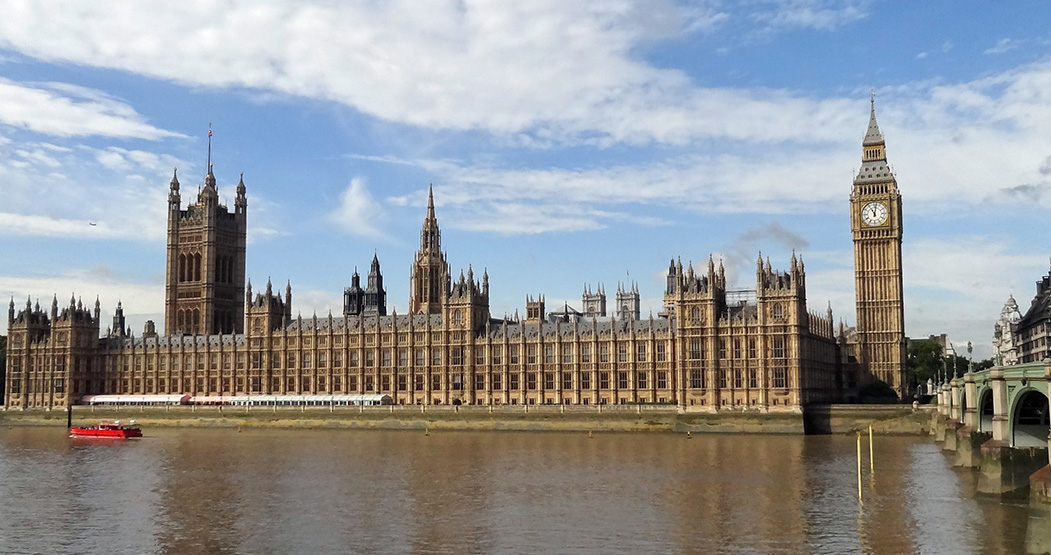 Discretionary fiscal measures in the UK are usually announced in annual Budget statements in the House of Commons. These are normally in March, but discretionary fiscal changes can be made in the Autumn Statement too. The Autumn Statement of October 2022, for example, took on significant importance as the new Chancellor of the Exchequer, Jeremy Hunt, tried to present a ‘safe pair hands’ following the fallout and market turbulence in response to the fiscal statement by the former Chancellor, Kwasi Kwarteng, on 23 September that year.
Discretionary fiscal measures in the UK are usually announced in annual Budget statements in the House of Commons. These are normally in March, but discretionary fiscal changes can be made in the Autumn Statement too. The Autumn Statement of October 2022, for example, took on significant importance as the new Chancellor of the Exchequer, Jeremy Hunt, tried to present a ‘safe pair hands’ following the fallout and market turbulence in response to the fiscal statement by the former Chancellor, Kwasi Kwarteng, on 23 September that year.
The fiscal impulse
The large-scale economic turbulence of recent years associated first with the global financial crisis of 2007–9 and then with the COVID-19 pandemic and the cost-of-living crisis, has seen governments respond with significant discretionary fiscal measures. During the COVID-19 pandemic, examples of fiscal interventions in the UK included the COVID-19 Business Interruption Loan Scheme (CBILS), grants for retail, hospitality and leisure businesses, the COVID-19 Job Retention Scheme (better known as the furlough scheme) and the Self-Employed Income Support Scheme.
 The size of discretionary fiscal interventions can be measured by the fiscal impulse. This captures the magnitude of change in discretionary fiscal policy and thus the size of the stimulus. The concept is not to be confused with fiscal multipliers, which measure the impact of fiscal changes on economic outcomes, such as real national income and employment.
The size of discretionary fiscal interventions can be measured by the fiscal impulse. This captures the magnitude of change in discretionary fiscal policy and thus the size of the stimulus. The concept is not to be confused with fiscal multipliers, which measure the impact of fiscal changes on economic outcomes, such as real national income and employment.
By measuring fiscal impulses, we can analyse the extent to which a country’s fiscal stance has tightened, loosened, or remained unchanged. In other words, we are attempting to capture discretionary fiscal policy changes that result in structural changes in the government budget and, therefore, in structural changes in spending and/or taxation.
To measure structural changes in the public-sector’s budgetary position, we calculate changes in structural budget balances.
A budget balance is simply the difference between receipts (largely taxation) and spending. A budget surplus occurs when receipts are greater than spending, while a deficit (sometimes referred to as net borrowing) occurs if spending is greater than receipts.
A structural budget balance cyclically-adjusts receipts and spending and hence adjusts for the position of the economy in the business cycle. In doing so, it has the effect of adjusting both receipts and spending for the effect of automatic stabilisers. Another way of thinking about this is to ask what the balance between receipts and spending would be if the economy were operating at its potential output. A deterioration in a structural budget balance infers a rise in the structural deficit or fall in the structural surplus. This indicates a loosening of the fiscal stance. An improvement in the structural budget balance, by contrast, indicates a tightening.
The size of UK fiscal impulses
A frequently-used measure of the fiscal impulse involves the change in the cyclically-adjusted public-sector primary deficit.
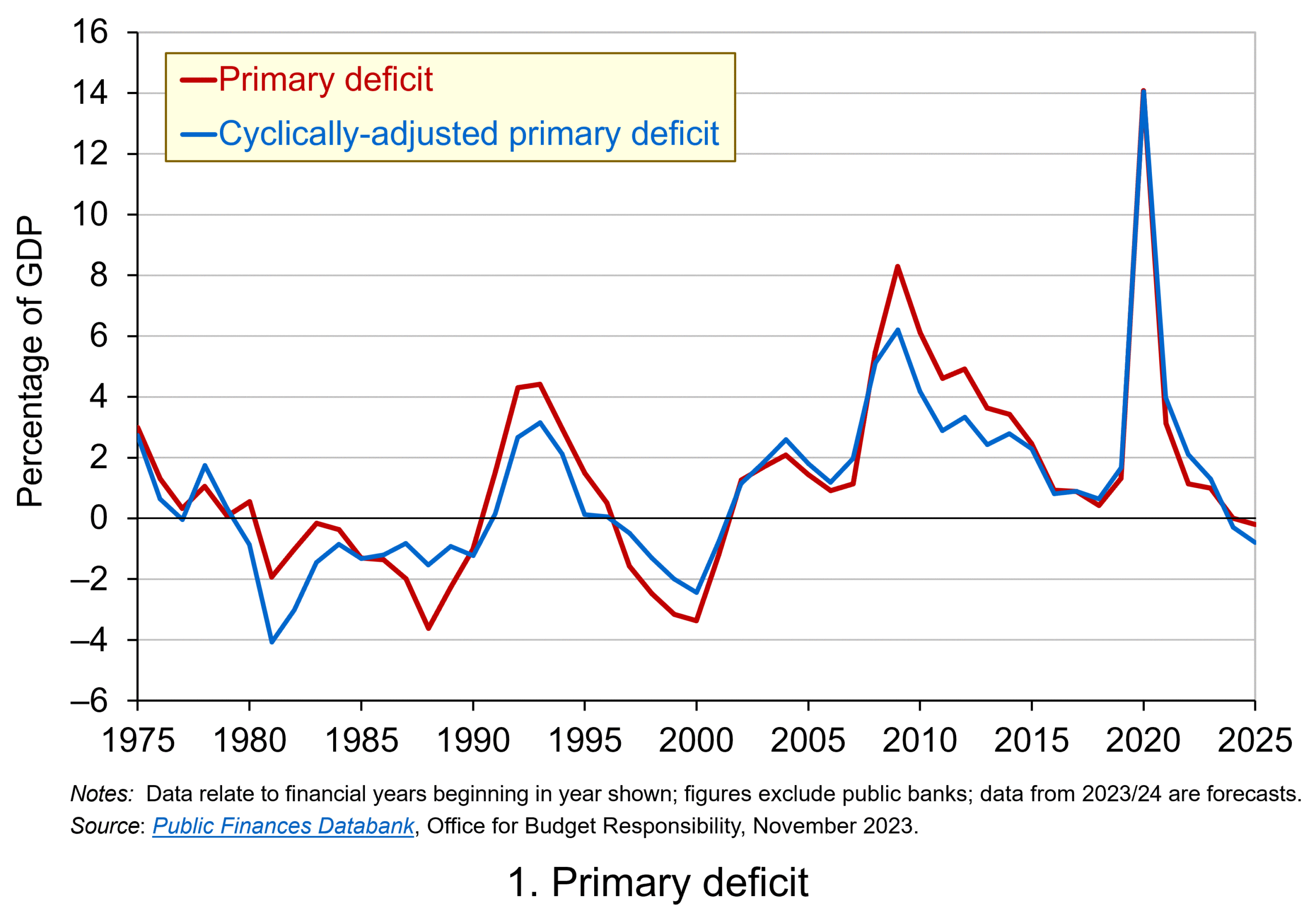 A primary deficit captures the extent to which the receipts of the public sector fall short of its spending, excluding its spending on debt interest payments. It essentially captures whether the public sector is able to afford its ‘new’ fiscal choices from its receipts; it excludes debt-servicing costs, which can be thought of as reflecting fiscal choices of the past. By using a cyclically-adjusted primary deficit we are able to isolate more accurately the size of discretionary policy changes. Chart 1 shows the UK’s actual and cyclically-adjusted primary deficit as a share of GDP since 1975, which have averaged 1.3 and 1.1 per cent of GDP respectively. (Click here for a PowerPoint of the chart.)
A primary deficit captures the extent to which the receipts of the public sector fall short of its spending, excluding its spending on debt interest payments. It essentially captures whether the public sector is able to afford its ‘new’ fiscal choices from its receipts; it excludes debt-servicing costs, which can be thought of as reflecting fiscal choices of the past. By using a cyclically-adjusted primary deficit we are able to isolate more accurately the size of discretionary policy changes. Chart 1 shows the UK’s actual and cyclically-adjusted primary deficit as a share of GDP since 1975, which have averaged 1.3 and 1.1 per cent of GDP respectively. (Click here for a PowerPoint of the chart.)
The size of the fiscal impulse is measured by the year-on-year percentage point change in the cyclically-adjusted public-sector primary deficit as a percentage of GDP. A larger deficit or a smaller surplus indicates a fiscal loosening (a positive fiscal impulse), while a smaller deficit or a larger surplus indicates a fiscal tightening (a negative fiscal impulse).
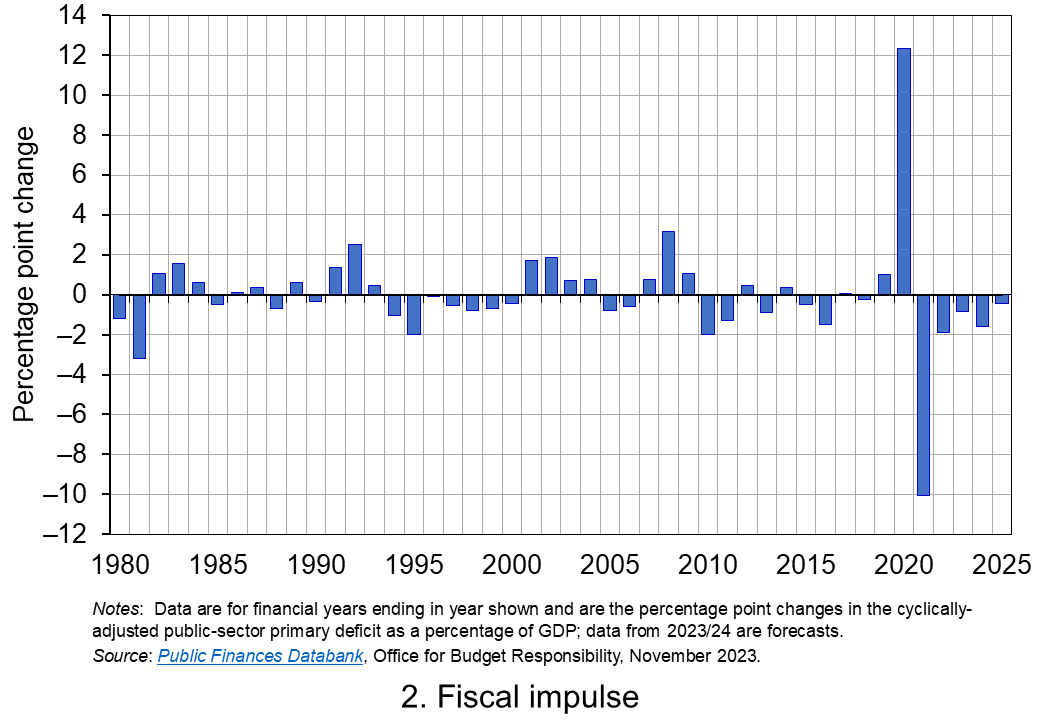 Chart 2 shows the magnitude of UK fiscal impulses since 1980. It captures very starkly the extent of the loosening of the fiscal stance in 2020 in response to the COVID-19 pandemic. (Click here for a PowerPoint of the chart.) In 2020 the cyclically-adjusted primary deficit to GDP ratio rose from 1.67 to 14.04 per cent. This represents a positive fiscal impulse of 12.4 per cent of GDP.
Chart 2 shows the magnitude of UK fiscal impulses since 1980. It captures very starkly the extent of the loosening of the fiscal stance in 2020 in response to the COVID-19 pandemic. (Click here for a PowerPoint of the chart.) In 2020 the cyclically-adjusted primary deficit to GDP ratio rose from 1.67 to 14.04 per cent. This represents a positive fiscal impulse of 12.4 per cent of GDP.
A tightening of fiscal policy followed the waning of the pandemic. 2021 saw a negative fiscal impulse of 10.1 per cent of GDP. Subsequent tightening was tempered by policy measures to limit the impact on the private sector of the cost-of-living crisis, including the Energy Price Guarantee and Energy Bills Support Scheme.
In comparison, the fiscal response to the global financial crisis led to a cumulative increase in the cyclically-adjusted primary deficit to GDP ratio from 2007 to 2009 of 5.0 percentage points. Hence, the financial crisis saw a positive fiscal impulse of 5 per cent of GDP. While smaller in comparison to the discretionary fiscal responses to the COVID-19 pandemic, it was, nonetheless, a sizeable loosening of the fiscal stance.
Sustainability and well-being of the public finances
The recent fiscal interventions have implications for the financial well-being of the public-sector. Not least, the financing of the positive fiscal impulses has led to a substantial growth in the accumulated size of the public-sector debt stock. At the end of 2006/7 the public-sector net debt stock was 35 per cent of GDP; at the end of the current financial year, 2023/24, it is expected to be 103 per cent.
As we saw at the outset, in an environment of rising interest rates, the increase in the public-sector debt to GDP ratio creates significant additional costs for government, a situation that is made more difficult for government not only by the current flatlining of economic activity, but by the low underlying rate of economic growth seen since the financial crisis. The combination of higher interest rates and lower economic growth has adverse implications for the sustainability of the public finances and the ability of the public sector to absorb the effects of future economic crises.
Articles
- Autumn Statement 2023: When is it and how will it affect me?
BBC News (16/11/23)
- What is the Autumn Statement?
House of Commons Library (13/11/23)
- Putting the fiscal toothpaste back into the tube: It’s time to normalise the euro area fiscal stance in 2024
VoxEU, Niels Thygesen, Roel Beetsma, Massimo Bordignon, Xavier Debrun, Mateusz Szczurek, Martin Larch, Matthias Busse, Mateja Gabrijelcic, Laszlo Jankovics and Janis Malzubris (30/6/23)
- Euro zone should tighten fiscal policy in 2024 to curb inflation, European Fiscal Board says
Reuters, Jan Strupczewski (28/6/23)
- Hutchins Center Fiscal Impact Measure: Federal, State and Local Fiscal Policy and the Economy
Brookings, Eli Asdourian, Louise Sheiner, and Lorae Stojanovic (27/10/23)
Report
- IFS Green Budget
Institute for Fiscal Studies, Carl Emmerson, Paul Johnson and Ben Zaranko (eds) (October 2023)
Data
Questions
- Explain what is meant by the following fiscal terms: (a) structural deficit; (b) automatic stabilisers; (c) discretionary fiscal policy; (d) primary deficit.
- What is the difference between current and capital public expenditures? Give some examples of each.
- Consider the following two examples of public expenditure: grants from government paid to the private sector for the installation of energy-efficient boilers, and welfare payments to unemployed people. How are these expenditures classified in the public finances and what fiscal objectives do you think they meet?
- Which of the following statements about the primary balance is FALSE?
(a) In the presence of debt interest payments a primary deficit will be smaller than a budget deficit.
(b) In the presence of debt interest payments a primary surplus will be smaller than a budget surplus.
(c) The primary balance differs from the budget balance by the size of debt interest payments.
(d) None of the above.
- Explain the difference between a fiscal impulse and a fiscal multiplier.
- Why is low economic growth likely to affect the sustainability of the public finances? What other factors could also matter?
 The Autumn Statement was announced by Jeremy Hunt in Parliament on Thursday 17th November. This was Hunt’s first big speech since becoming Chancellor or the Exchequer a few weeks ago. He revealed to the House of Commons that there will be tax rises and spending cuts worth billions of pounds, aimed at mending the nation’s finances. It is hoped that the new plans will restore market confidence shaken by his predecessor’s mini-Budget. He claimed that the mixture of tax rises and spending cuts would be distributed fairly.
The Autumn Statement was announced by Jeremy Hunt in Parliament on Thursday 17th November. This was Hunt’s first big speech since becoming Chancellor or the Exchequer a few weeks ago. He revealed to the House of Commons that there will be tax rises and spending cuts worth billions of pounds, aimed at mending the nation’s finances. It is hoped that the new plans will restore market confidence shaken by his predecessor’s mini-Budget. He claimed that the mixture of tax rises and spending cuts would be distributed fairly.
What is the Autumn statement?
The March Budget is the government’s main financial plan, where it decides how much money people will be taxed and where that money will be spent. The Autumn Statement is like a second Budget. This is an update half a year later on how things are going. However, that doesn’t mean it is not as important. This year’s Autumn Statement is especially important given the number of changes in government in recent months. The Statement unfortunately comes at a time when the cost of living is rising at its fastest rate for 41 years, meaning that it is going to be a tough winter for many people.
Statement overview
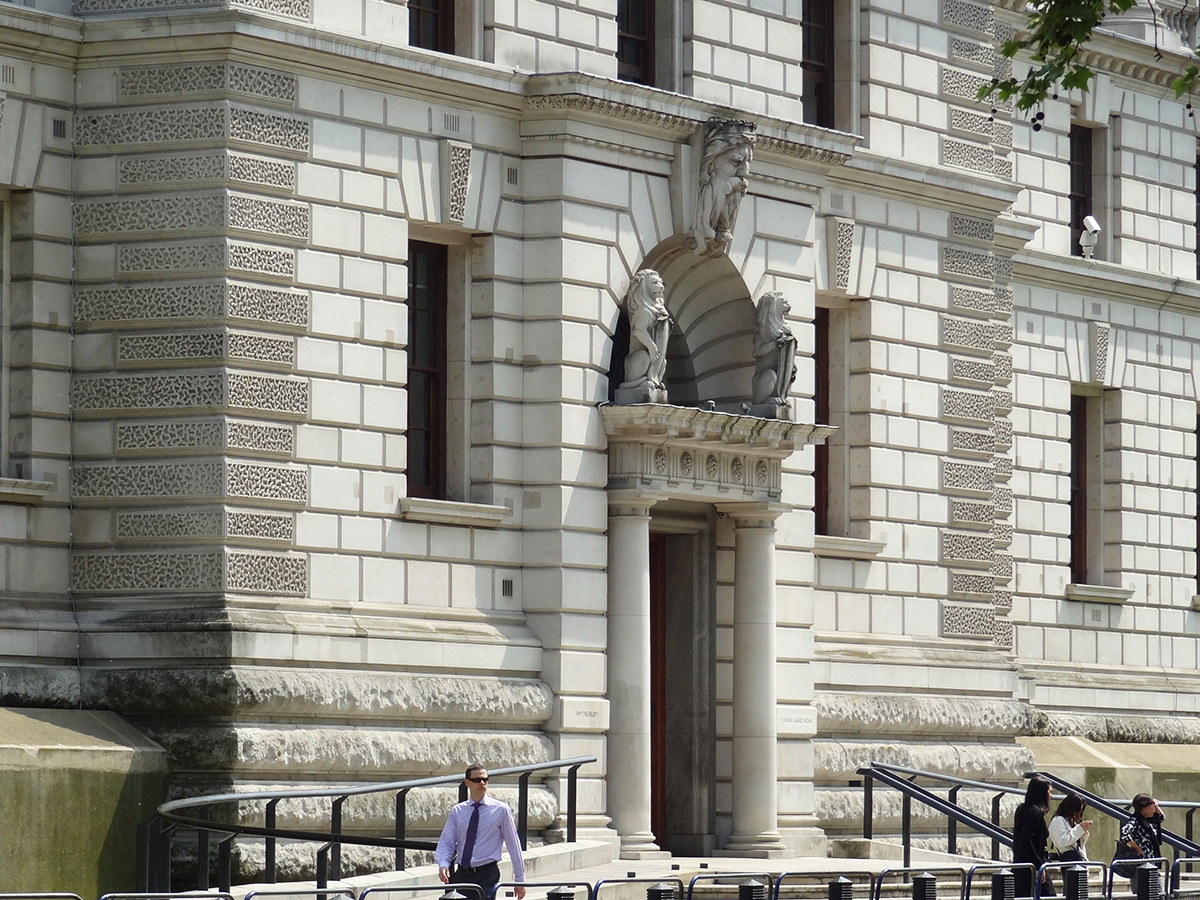 It was expected that the Statement was not going to be one to celebrate, given that the UK is now believed to be in a recession. The Office for Budget Responsibility (OBR) forecasts that the UK economy will shrink by 1.4% next year. However, Hunt said that his focus was on stability and ensuring a shallower downturn. The Chancellor outlined his ‘plan for stability’ by announcing deep spending cuts and tax rises in the autumn statement. He said that half of his £55bn plan would come from tax rises, and the rest from spending cuts.
It was expected that the Statement was not going to be one to celebrate, given that the UK is now believed to be in a recession. The Office for Budget Responsibility (OBR) forecasts that the UK economy will shrink by 1.4% next year. However, Hunt said that his focus was on stability and ensuring a shallower downturn. The Chancellor outlined his ‘plan for stability’ by announcing deep spending cuts and tax rises in the autumn statement. He said that half of his £55bn plan would come from tax rises, and the rest from spending cuts.
The Chancellor plans to tackle rising prices and restore the UK’s credibility with international markets. He said that it will be a balanced path to stability, with the need to tackle inflation to bring down the cost of living while also supporting the economy on a path to sustainable growth. It will mean further concerns for many, but the Chancellor argued that the most vulnerable in society are being protected. He stated that despite difficult decisions being made, the plan was fair.
What was announced?
The government’s overall strategy appears to assume that, by tightening fiscal policy, monetary policy will not have to tighten as much. The hopeful consequence of which is that interest rates will be lower than they otherwise would have been. This means interest-rate sensitive parts of the economy, the housing sector in particular, are more protected than it would have been.
The following are some of the key measures announced:
- Tax thresholds will be frozen until April 2028, meaning millions will pay more tax as their nominal incomes rise.
- Spending on public services in England will rise more slowly than planned – with some departments facing cuts after the next election.
- The state pensions triple lock will be kept, meaning pensioners will see a 10.1% rise in weekly payments.
- The household energy price cap per unit of gas and electricity has been extended for one year beyond April but made less generous, with typical bills then being £3000 a year instead of £2500.
- There will be additional cost-of-living payments for the ‘most vulnerable’, with £900 for those on benefits, and £300 for pensioners.
- The top 45% additional rate of income tax will be paid on earnings over £125 140 instead of £150 000.
- The UK minimum wage (or ‘National Living Wage’ as the government calls it) for people over 23 will increase from £9.50 to £10.42 per hour.
- The windfall tax on oil and gas firms will increase from 25% to 35%, raising £55bn over the period from now until 2028.
The public finances
A key feature of the Autumn Statement was the Chancellor’s attempt to tackle the deteriorating public finances and to reduce the public-sector deficit and debt. The following three charts are based on data from the OBR (see data links below). They all show data for financial years beginning in the year shown. They all include OBR forecasts up to 2025/26, with the forecasts being based on the measures announced in the Autumn Statement.
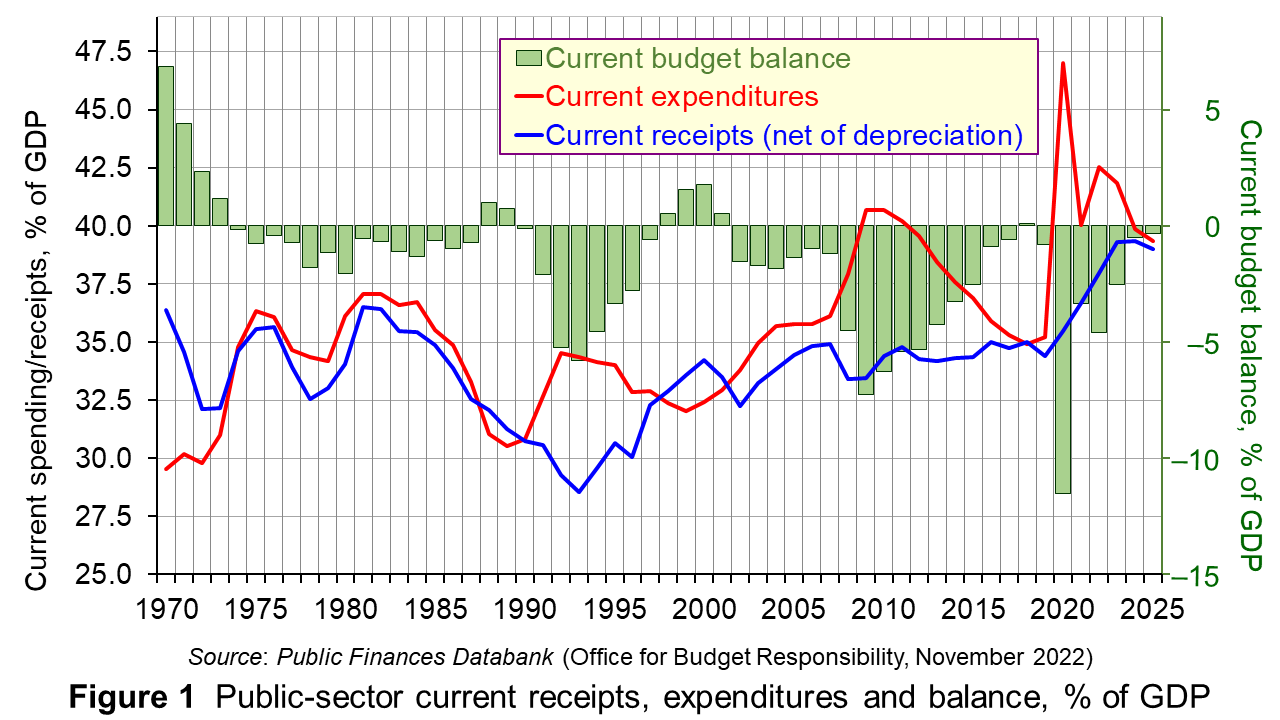 Figure 1 shows public-sector current expenditure and receipts and the balance between them, giving the current deficit (or surplus), shown by the green bars. Current expenditure excludes capital expenditure on things such as hospitals, schools and roads. Since 1973, there has been a current deficit in most years. However, the deficit of 11.5% of GDP in 2020/21 was exceptional given government support measures for households and business during the pandemic. The deficit fell to 3.3% in 2021/22, but is forecast to grow to 4.6% in 2022/23 thanks to government subsidies to energy suppliers to allow energy prices to be capped. (Click here for a PowerPoint of this chart.)
Figure 1 shows public-sector current expenditure and receipts and the balance between them, giving the current deficit (or surplus), shown by the green bars. Current expenditure excludes capital expenditure on things such as hospitals, schools and roads. Since 1973, there has been a current deficit in most years. However, the deficit of 11.5% of GDP in 2020/21 was exceptional given government support measures for households and business during the pandemic. The deficit fell to 3.3% in 2021/22, but is forecast to grow to 4.6% in 2022/23 thanks to government subsidies to energy suppliers to allow energy prices to be capped. (Click here for a PowerPoint of this chart.)
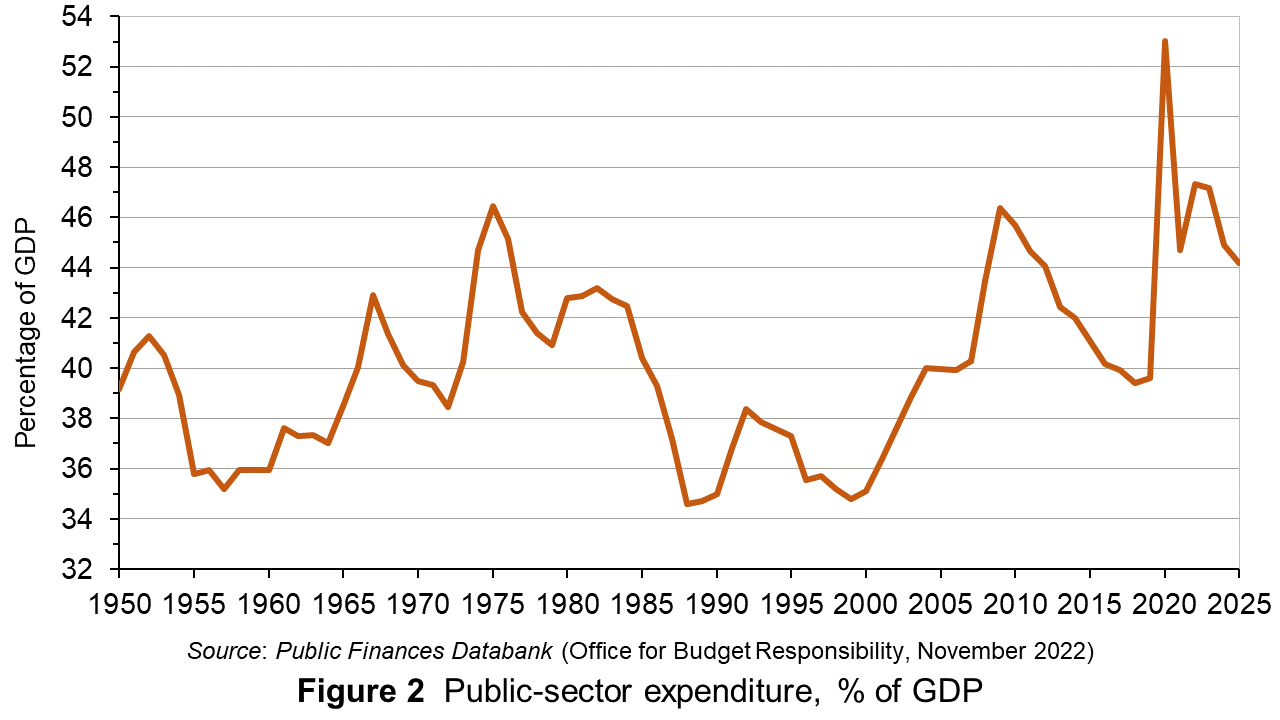 Figure 2 shows public-sector expenditure (current plus capital) from 1950. You can see the spike after the financial crisis of 2007–8 when the government introduced various measures to support the banking system. You can also see the bigger spike in 2020/21 when pandemic support measures saw government expenditure rise to a record 53.0% of GDP. It has risen again this financial year to a predicted to 47.3% of GDP from 44.7% last financial year. It is forecast to fall only slightly, to 47.2%, in 2023/24, before then falling more substantially as the tax rises and spending cuts announced in the Autumn Statement start to take effect. (Click here for a PowerPoint of this chart.)
Figure 2 shows public-sector expenditure (current plus capital) from 1950. You can see the spike after the financial crisis of 2007–8 when the government introduced various measures to support the banking system. You can also see the bigger spike in 2020/21 when pandemic support measures saw government expenditure rise to a record 53.0% of GDP. It has risen again this financial year to a predicted to 47.3% of GDP from 44.7% last financial year. It is forecast to fall only slightly, to 47.2%, in 2023/24, before then falling more substantially as the tax rises and spending cuts announced in the Autumn Statement start to take effect. (Click here for a PowerPoint of this chart.)
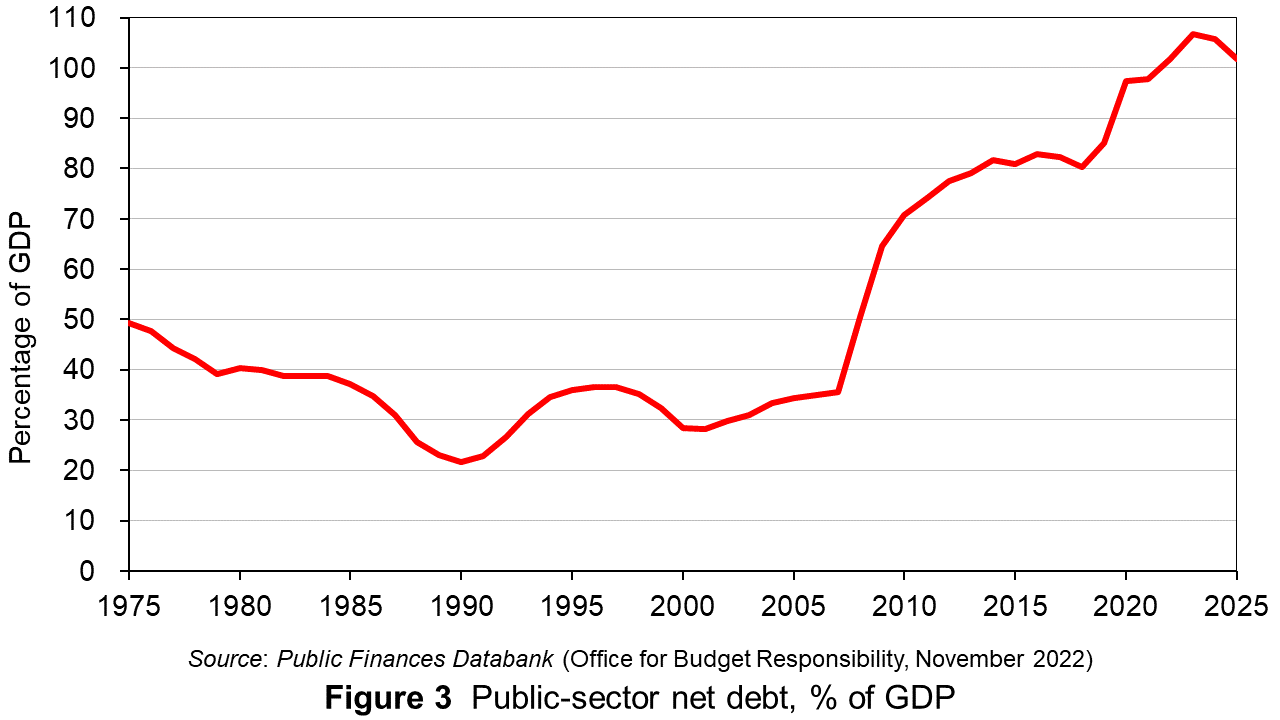 Figure 3 shows public-sector debt since 1975. COVID support measures, capping energy prices and a slow growing or falling GDP have contributed to a rise in debt as a proportion of GDP since 2020/21. Debt is forecast to peak in 2023/24 at a record 106.7% of GDP. During the 20 years from 1988/89 to 2007/8 it averaged just 30.9% of GDP. After the financial crisis of 2007–8 it rose to 81.6% by 2014/15 and then averaged 82.2% between 2014/15 and 2019/20. (Click here for a PowerPoint of this chart.)
Figure 3 shows public-sector debt since 1975. COVID support measures, capping energy prices and a slow growing or falling GDP have contributed to a rise in debt as a proportion of GDP since 2020/21. Debt is forecast to peak in 2023/24 at a record 106.7% of GDP. During the 20 years from 1988/89 to 2007/8 it averaged just 30.9% of GDP. After the financial crisis of 2007–8 it rose to 81.6% by 2014/15 and then averaged 82.2% between 2014/15 and 2019/20. (Click here for a PowerPoint of this chart.)
Criticism
The government has been keen to stress that Mr Hunt’s statement does not amount to a return to the austerity policies of the Conservative-Liberal Democrat coalition government, in office between 2010 and 2015. However, Labour Shadow Chancellor, Rachel Reeves, said Mr Hunt’s Autumn Statement was an ‘invoice for the economic carnage’ the Conservative government had created. There have also been some comments raised by economists questioning the need for spending cuts and tax rises on this scale, with some saying that the decisions being made are political.
 Paul Johnson, the director of the Institute for Fiscal Studies has commented on the plans, stating that the British people ‘just got a lot poorer’ after a series of ‘economic own goals’ that have made a recovery much harder than it might have been. He went on to say that the government was ‘reaping the costs of a long-term failure to grow the economy’, along with an ageing population and high levels of historic borrowing.
Paul Johnson, the director of the Institute for Fiscal Studies has commented on the plans, stating that the British people ‘just got a lot poorer’ after a series of ‘economic own goals’ that have made a recovery much harder than it might have been. He went on to say that the government was ‘reaping the costs of a long-term failure to grow the economy’, along with an ageing population and high levels of historic borrowing.
Disapproval also came from Conservative MP, Jacob Rees-Mogg, who criticised the government’s tax increases. He raised concerns about the government’s plans to increase taxation when the economy is entering a recession. He said, ’You would normally expect there to be some fiscal support for an economy in recession.’
Economic Outlook
High inflation and rising interest rates will lead to consumers spending less, tipping the UK’s economy into a recession, which the OBR expects to last for just over a year. Its forecasts show that the economy will grow by 4.2% this year but will shrink by 1.4% in 2023, before growth slowly picks up again. GDP should then rise by 1.3% in 2024, 2.6% in 2025 and 2.7% in 2026.
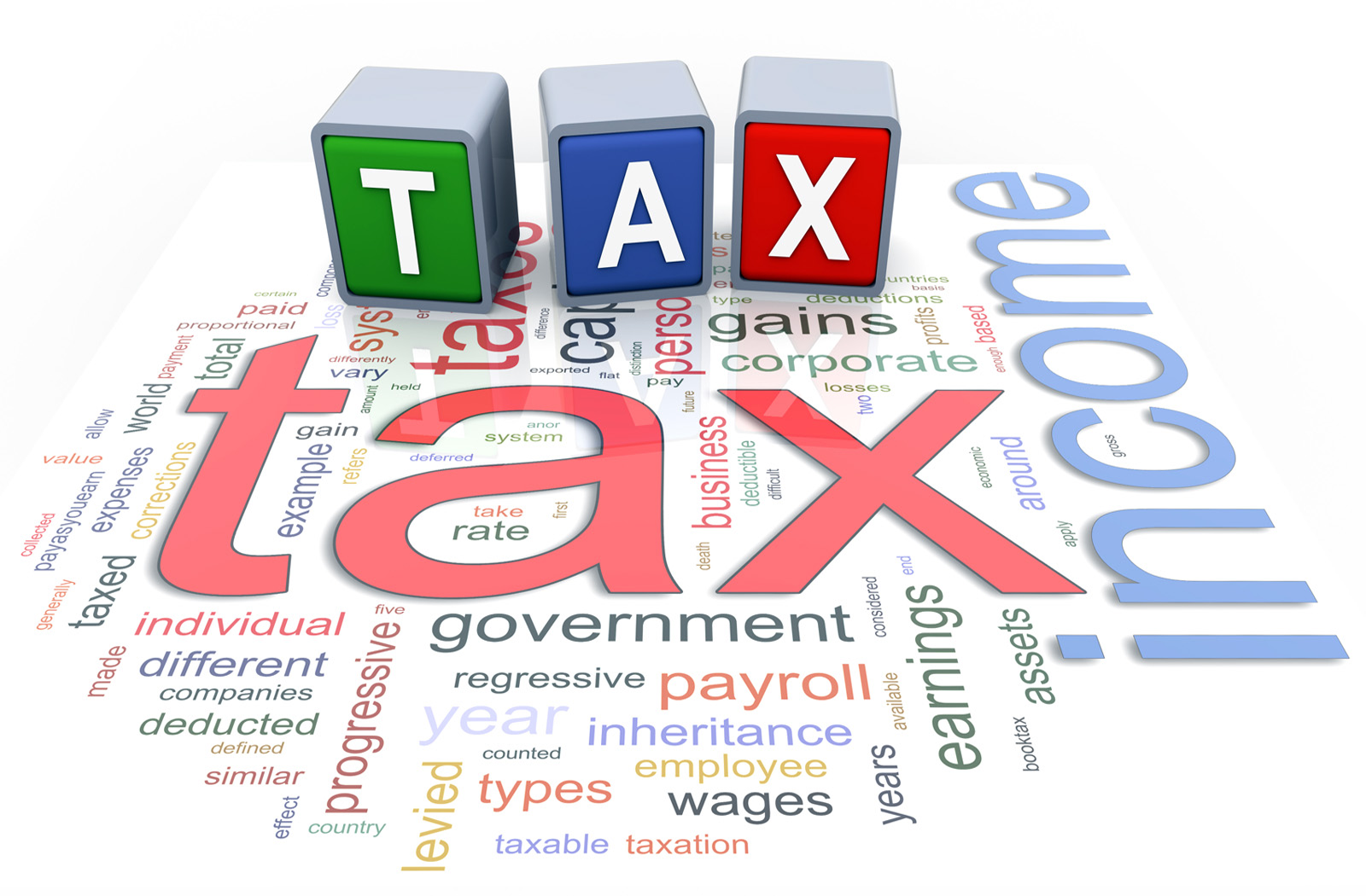 The OBR predicts that there will be 3.2 million more people paying income tax between 2021/22 and 2027/28 as a result of the new tax policy and many more paying higher taxes as a proportion of their income. This is because they will be dragged into higher tax bands as thresholds and allowances on income tax, national insurance and inheritance tax have been frozen until 2028. Government documents said these decisions on personal taxes would raise an additional £3.5bn by 2028 – the consequence of ‘fiscal drag’ pulling more Britons into higher tax brackets. The OBR expects that there will be an extra 2.6 million paying tax at the higher, 40% rate. This is going to put more pressure on households who are already feeling the impact of inflation on their disposable income.
The OBR predicts that there will be 3.2 million more people paying income tax between 2021/22 and 2027/28 as a result of the new tax policy and many more paying higher taxes as a proportion of their income. This is because they will be dragged into higher tax bands as thresholds and allowances on income tax, national insurance and inheritance tax have been frozen until 2028. Government documents said these decisions on personal taxes would raise an additional £3.5bn by 2028 – the consequence of ‘fiscal drag’ pulling more Britons into higher tax brackets. The OBR expects that there will be an extra 2.6 million paying tax at the higher, 40% rate. This is going to put more pressure on households who are already feeling the impact of inflation on their disposable income.
However, this pressure on incomes is set to continue, with real incomes falling by the largest amount since records began in 1956. Real household incomes are forecast to fall by 7% in the next few years, which even after the support from the government, is the equivalent of £1700 per year on average. And the number unemployed is expected to rise by more than 500 000. Senior research economist at the IFS, Xiaowei Xu, described the UK as heading for another lost decade of income growth.
There may be some good news for inflation, with suggestions that it has now peaked. The OBR forecasts that the inflation rate will drop to 7.4% next year. This is still a concern, however, given that the target set for inflation is 2%. Despite the inflation rate potentially peaking, the impact on households has not. The fall in the inflation rate does not mean that prices in the shops will be going down. It just means that they will be going up more slowly than now. The OBR expects that prices will not start to fall (inflation becoming negative) until late 2024.
Conclusion
The overall tone of the government’s announcements was no surprise and policies were largely expected by the markets, hence their muted response. However, this did not make them any less economically painful. There are major concerns for households over what they now face over the next few years, something that the government has not denied.
It has been suggested that this situation, however, has been made worse by historic choices, including cutting state capital spending, cuts in the budget for vocational education, Brexit and Kwasi Kwarteng’s mini-Budget. It is evident that Britons have a tough time ahead in the next year or so. The UK has already had one lost decade of flatlining living standards since the global financial crisis and is now heading for another one with the cost of living crisis.
Articles
- Autumn Statement 2022: Key points at-a-glance
BBC News (17/11/22)
- Autumn statement 2022: key points at a glance
The Guardian, Richard Partington and Aubrey Allegretti (17/11/22)
 Next two years will be ‘challenging’, says Chancellor Jeremy Hunt – as disposable incomes head for biggest fall on record
Next two years will be ‘challenging’, says Chancellor Jeremy Hunt – as disposable incomes head for biggest fall on recordSky News, Sophie Morris (18/11/22)
- What the Autumn Statement means for you and the cost of living
BBC News, Kevin Peachey (17/11/22)
- Autumn Statement: Jeremy Hunt warns of challenges as living standards plunge
BBC News, Kate Whannel (17/11/22)
- Autumn Statement: BBC experts on six things you need to know
BBC News (17/11/22)
- Autumn statement 2022: experts react
The Conversation (17/11/22)
- Autumn Statement Special: Top of the Charts
Resolution Foundation, Torsten Bell (18/11/22)
- Jeremy Hunt’s autumn statement is a poisoned chalice for whoever wins the next election
The Conversation, Steve Schifferes (18/11/22)
- UK households face largest fall in living standards in six decades
Financial Times, Delphine Strauss (17/11/22)
- How the autumn statement brought back the ‘squeezed middle’
The Guardian, Larry Elliott (18/11/22)
- The British people ‘just got a lot poorer’, says IFS thinktank
The Guardian, Anna Isaac (18/11/22)
- Autumn Statement: Hunt has picked pockets of entire country, Labour says
BBC News, Joshua Nevett (17/11/22)
- UK government announces budget; country faces largest fall in living standards since records began
CNBC, Elliot Smith (17/11/22)
- The first step to Britain’s economic recovery is to start telling the truth
The Observer, Will Hutton (20/11/22)
Videos
Analysis
- Autumn Statement 2022 response
Institute for Fiscal Studies, Stuart Adam, Carl Emmerson, Paul Johnson, Robert Joyce, Heidi Karjalainen, Peter Levell, Isabel Stockton, Tom Waters, Thomas Wernham, Xiaowei Xu and Ben Zaranko (17/11/22)
- Help today, squeeze tomorrow: Putting the 2022 Autumn Statement in context
Resolution Foundation, Torsten Bell, Mike Brewer, Molly Broome, Nye Cominetti, Adam Corlett, Emily Fry, Sophie Hale, Karl Handscomb, Jack Leslie, Jonathan Marshall, Charlie McCurdy, Krishan Shah, James Smith,
Gregory Thwaites & Lalitha Try (18/11/22)
Government documentation
Data
Questions
- What do you understand by the term ‘fiscal drag’?
- Provide a critique of the Autumn Statement from the left.
- Provide a critique of the Autumn Statement from the right.
- What are the concerns about raising taxation during a recession?
- Define the term ‘windfall tax’. What are the advantages and disadvantages of imposing/increasing windfall taxes on energy producers in the current situation?
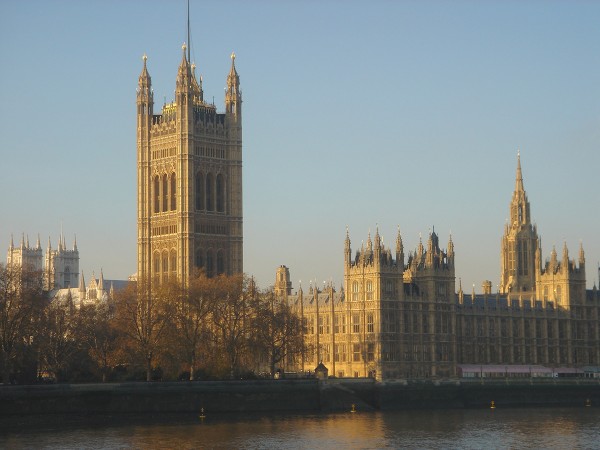 In his 2016 Autumn Statement, the new Chancellor of the Exchequer, Philip Hammond, announced that he was abandoning his predecessor’s target of achieving a budget surplus in 2019/20 and beyond. This was partly in recognition that tax revenues were likely to be down as economic growth forecasts were downgraded by the Office for Budget Responsibility. But it was partly to give himself more room to boost the economy in response to lower economic growth. In other words, he was moving from a strictly rules-based fiscal policy to one that is more interventionist.
In his 2016 Autumn Statement, the new Chancellor of the Exchequer, Philip Hammond, announced that he was abandoning his predecessor’s target of achieving a budget surplus in 2019/20 and beyond. This was partly in recognition that tax revenues were likely to be down as economic growth forecasts were downgraded by the Office for Budget Responsibility. But it was partly to give himself more room to boost the economy in response to lower economic growth. In other words, he was moving from a strictly rules-based fiscal policy to one that is more interventionist.
Although he still has the broad target of reducing government borrowing over the longer term, this new flexibility allowed him to announce increased government spending on infrastructure.
The new approach is outlined in the updated version of the Charter for Budget
Responsibility, published alongside the Autumn Statement. The government’s fiscal mandate would now include the following:
|
|
| • |
a target to reduce cyclically-adjusted public-sector net borrowing to below 2% of GDP by 2020/21; |
| • |
a target for public-sector net debt as a percentage of GDP to be falling in 2020/21. |
It also states that:
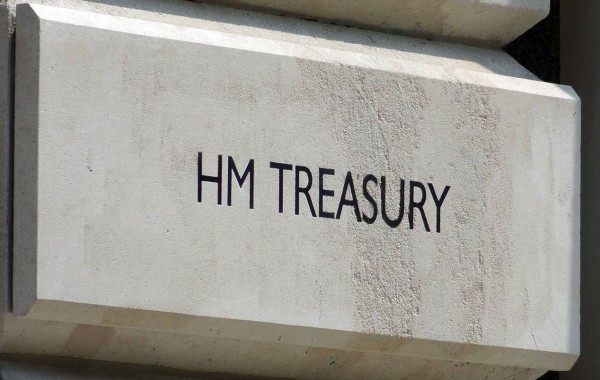 In the event of a significant negative shock to the UK economy, the Treasury will review the appropriateness of the fiscal mandate and supplementary targets as a means of returning the public finances to balance as early as possible in the next Parliament.
In the event of a significant negative shock to the UK economy, the Treasury will review the appropriateness of the fiscal mandate and supplementary targets as a means of returning the public finances to balance as early as possible in the next Parliament.
In the Autumn Statement, the new approach to fiscal policy is summarised as follows:
This new fiscal framework ensures the public finances continue on the path to sustainability, while providing the flexibility needed to support the economy in the near term.
With his new found freedom, the Chancellor was able to announce spending increases, despite deteriorating public finances, of £36bn by 2021/22 (see Table 1 in the Autumn Statement).
Most of the additional expenditure will be on infrastructure. To facilitate this, the government will set up a new National Productivity Investment Fund (NPIF)  to channel government spending to various infrastructure projects in the fields of housing, transport, telecoms and research and development. The NPIF will provide £23bn to such projects between 2017/18 and 2021/22.
to channel government spending to various infrastructure projects in the fields of housing, transport, telecoms and research and development. The NPIF will provide £23bn to such projects between 2017/18 and 2021/22.
But much of the additional flexibility in the new Fiscal Mandate will be to allow automatic fiscal stabilisers to operate. The OBR forecasts an increase in borrowing of £122bn over the 2017/18 to 2021/22 period compared with its forecasts made in March this year. Apart from the additional £23bn spending on infrastructure, most of the rest will be as a result of lower tax receipts from lower economic growth. This, in turn, is forecast to be the result of lower investment caused by Brexit uncertainties and lower real consumer spending because of the fall in the pound and the consequent rise in prices.
But rather than having to tighten fiscal policy to meet the previous borrowing target, the new Fiscal Mandate will permit this rise in borrowing. The lower tax payments will help to reduce the dampening effect on the economy.
So are we entering a new era of fiscal policy? Is the government now using discretionary fiscal policy to boost aggregate demand, while also attempting to increase productivity? Or is the relaxation of the Fiscal Mandate just a redrawing of the rules to give a bit more flexibility over the level of stimulus the government can give the economy?
Videos
 Autumn Statement 2016: Philip Hammond’s speech (in full) GOV.UK (23/11/16)
Autumn Statement 2016: Philip Hammond’s speech (in full) GOV.UK (23/11/16)
 Philip Hammond’s autumn statement – video highlights The Guardian (23/11/16)
Philip Hammond’s autumn statement – video highlights The Guardian (23/11/16)
 Key points from the chancellor’s first Autumn Statement BBC News, Andrew Neil (23/11/16)
Key points from the chancellor’s first Autumn Statement BBC News, Andrew Neil (23/11/16)
 Autumn Statement: higher borrowing, lower growth Channel 4 News, Helia Ebrahimi (23/11/16)
Autumn Statement: higher borrowing, lower growth Channel 4 News, Helia Ebrahimi (23/11/16)
 Autumn Statement: Chancellor’s growth and borrowing figures BBC News (23/11/16)
Autumn Statement: Chancellor’s growth and borrowing figures BBC News (23/11/16)
 Markets react to Autumn Statement Financial Times on YouTube, Roger Blitz (23/11/16)
Markets react to Autumn Statement Financial Times on YouTube, Roger Blitz (23/11/16)
 Hammond’s Autumn Statement unpicked Financial Times on YouTube, Gemma Tetlow (23/11/16)
Hammond’s Autumn Statement unpicked Financial Times on YouTube, Gemma Tetlow (23/11/16)
 Autumn Statement 2016: The charts that show the cost of Brexit Sjy News, Ed Conway (24/11/16)
Autumn Statement 2016: The charts that show the cost of Brexit Sjy News, Ed Conway (24/11/16)
 BBC economics editor Kamal Ahmed on the Autumn Statement. BBC News (23/11/16)
BBC economics editor Kamal Ahmed on the Autumn Statement. BBC News (23/11/16)
 Autumn statement: debate Channel 4 News, Financial Secretary to the Treasury, Jane Ellison, and Labour’s Shadow Business Secretary, Clive Lewis (23/11/16)
Autumn statement: debate Channel 4 News, Financial Secretary to the Treasury, Jane Ellison, and Labour’s Shadow Business Secretary, Clive Lewis (23/11/16)
 Autumn Statement: Workers’ pay growth prospects dreadful, says IFS BBC News, Kevin Peachey and Paul Johnson (24/11/16)
Autumn Statement: Workers’ pay growth prospects dreadful, says IFS BBC News, Kevin Peachey and Paul Johnson (24/11/16)
Articles
Autumn Statement 2016: Expert comment on fiscal policy Grant Thornton, Adam Jackson (23/11/16)
Philip Hammond loosens George Osborne’s fiscal rules to give himself more elbow room as Brexit unfolds CityA.M., Jasper Jolly (23/11/16)
Britain’s New Fiscal Mandate Opens Way To Invest For Economic Growth Forbes, Linda Yueh (23/11/16)
Autumn Statement 2016: experts respond The Conversation (23/11/16)
Chancellor’s ‘Reset’ Leaves UK Economy Exposed And Vulnerable Huffington Post, Alfie Stirling (23/11/16)
Britain’s Autumn Statement hints at how painful Brexit is going to be The Economist (26/11/16)
Chancellor’s looser finance targets highlight weaker UK economy The Guardian, Phillip Inman (24/11/16)
Hammond’s less-than-meets-the-eye plan that hints at the future Financial Times, Martin Sandbu (23/11/16)
Economists’ views on Philip Hammond’s debut Financial Times, Paul Johnson, Bronwyn Curtis and Gerard Lyons (24/11/16)
Government Publications
Autumn Statement 2016 HM Treasury (23/11/16)
Charter for Budget Responsibility: autumn 2016 update HM Treasury
Reports, forecasts and analysis
Economic and fiscal outlook – November 2016 Office for Budget Responsibility (23/11/16)
Autumn Statement 2016 analysis Institute for Fiscal Studies (November 2016)
Questions
- Distinguish between discretionary fiscal policy and rules-based fiscal policy.
- Why have forecasts of the public finances worsened since last March?
- What is meant by automatic fiscal stabilisers? How do they work when the economic growth slows?
- What determines the size of the multiplier from public-sector infrastructure projects?
- What dangers are there in relaxing the borrowing rules in the Fiscal Mandate?
- Examine the arguments for relaxing the borrowing rules more than they have been?
- If the economy slows more than has been forecast and public-sector borrowing rises faster, does the Chancellor have any more discretion in giving a further fiscal boost to the economy?
- Does the adjustment of borrowing targets as the economic situation changes make such a policy a discretionary one rather than a rules-based one?
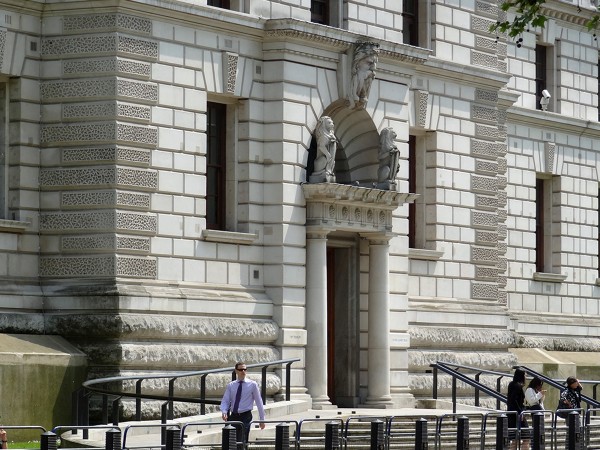 As the Chancellor of the Exchequer, Philip Hammond, delivers his first Autumn statement, both the Office for Budget Responsibility (OBR) and the National Institute for Economic and Social Research (NIESR) have published updated forecasts for government borrowing and government debt.
As the Chancellor of the Exchequer, Philip Hammond, delivers his first Autumn statement, both the Office for Budget Responsibility (OBR) and the National Institute for Economic and Social Research (NIESR) have published updated forecasts for government borrowing and government debt.
They show a rise in government borrowing compared with previous forecasts. The main reason for this is a likely slowdown in the rate of economic growth and hence in tax revenues, especially in 2017. Last March, the OBR forecast GDP growth of 2.2% for 2017; it has now revised this down to 1.4%.
This forecast slowdown is because of a likely decline in the growth of aggregate demand caused by a decline in investment as businesses become more cautious given the uncertainty about the UK’s relationships with the rest of the world post Brexit. There is also likely to be a slowdown in real consumer expenditure as inflation rises following the fall in the pound of around 15%.
But what might be more surprising is that the public finances are not forecast to deteriorate even further. The OBR forecasts that the deficit will increase by a total of £122bn to £216bn over the period from 2016/17 to 2020/21. The NIESR predicts that it will rise by only £50bn to £187bn – but this is before the additional infrastructure spending and other measures announced in the Autumn Statement.
 One reason is looser monetary policy. Following the Brexit vote, the Bank of England cut Bank Rate from 0.5% to 0.25% and introduced further quantitative easing. This makes it cheaper to finance government borrowing. What is more, the additional holdings of bonds by the Bank mean that the Bank returns to the government much of the interest (coupon payments) that would otherwise have been paid to the private sector.
One reason is looser monetary policy. Following the Brexit vote, the Bank of England cut Bank Rate from 0.5% to 0.25% and introduced further quantitative easing. This makes it cheaper to finance government borrowing. What is more, the additional holdings of bonds by the Bank mean that the Bank returns to the government much of the interest (coupon payments) that would otherwise have been paid to the private sector.
Then, depending on the nature of the UK’s post-Brexit relationships with the EU, there could be savings in contributions to the EU budget – but just how much, no-one knows at this stage.
Finally, it depends on just what effects the measures announced in the Autumn Statement will have on tax revenues and government spending. We will examine this in a separate blog.
But even though public-sector borrowing is likely to fall more slowly than before the Brexit vote, the trajectory is still downward. Indeed, the previous Chancellor, George Osborne, had set a target of achieving a public-sector surplus by 2019/20.
But, would eventually bringing the public finances into surplus be desirable? Apart from the dampening effect on aggregate demand, such a policy could lead to underinvestment in infrastructure and other public-sector capital. There is thus a strong argument for continuing to run a deficit on the public-sector capital account to fund public-sector investment – such investment will increase incomes and social wellbeing in the future. It makes sense for the government to borrow for investment, just as it makes sense for the private sector to do so.
Articles
Autumn Statement: Why the damage to the public finances from Brexit might not be as bad as some think Independent, Simon Kirby (22/11/16)
Three Facts about Debt and Deficits NIESR blogs, R Farmer (21/11/16)
Autumn Statement: Big increase in borrowing predicted BBC News, Anthony Reuben (23/11/16)
Data
Economic and fiscal outlook – November 2016 Office for Budget Responsibility (23/11/16)
Questions
- Why have the public finances deteriorated?
- How much have they deteriorated?
- What is likely to happen to economic growth over the next couple of years? Explain why.
- How has the cut in Bank Rate and additional quantitative easing introduced after the Brexit vote affected government borrowing?
- What is likely to happen to (a) public-sector borrowing; (b) public-sector debt as a proportion of GDP over the next few years?
- Why is a running a Budget surplus neither a necessary nor a sufficient condition for reducing the government debt to GDP ratio.
- What are the arguments for (a) having a positive public-sector debt; (b) increasing public-sector debt as a result of increased spending on infrastructure and other forms of public-sector capital?
 Since 2019, UK personal taxes (income tax and national insurance) have been increasing as a proportion of incomes and total tax revenues have been increasing as a proportion of GDP. However, in his Autumn Statement of 22 November, the Chancellor, Jeremy Hunt, announced a 2 percentage point cut in the national insurance rate for employees from 12% to 10%. The government hailed this as a significant tax cut. But, despite this, taxes are set to continue increasing. According to the Office for Budget Responsibility (OBR), from 2019/20 to 2028/29, taxes will have increased by 4.5 per cent of GDP (see chart below), raising an extra £44.6 billion per year by 2028/29. One third of this is the result of ‘fiscal drag’ from the freezing of tax thresholds.
Since 2019, UK personal taxes (income tax and national insurance) have been increasing as a proportion of incomes and total tax revenues have been increasing as a proportion of GDP. However, in his Autumn Statement of 22 November, the Chancellor, Jeremy Hunt, announced a 2 percentage point cut in the national insurance rate for employees from 12% to 10%. The government hailed this as a significant tax cut. But, despite this, taxes are set to continue increasing. According to the Office for Budget Responsibility (OBR), from 2019/20 to 2028/29, taxes will have increased by 4.5 per cent of GDP (see chart below), raising an extra £44.6 billion per year by 2028/29. One third of this is the result of ‘fiscal drag’ from the freezing of tax thresholds.
 The net effect is that, although national insurance rates have been cut by 2 percentage points, the tax burden will continue rising. The OBR estimates that by 2027/28, tax revenues will be 37.4% of GDP; they were 33.1% in 2019/20. This is illustrated in the chart (click here for a PowerPoint).
The net effect is that, although national insurance rates have been cut by 2 percentage points, the tax burden will continue rising. The OBR estimates that by 2027/28, tax revenues will be 37.4% of GDP; they were 33.1% in 2019/20. This is illustrated in the chart (click here for a PowerPoint).  Support measures during the pandemic and its aftermath and subsidies for energy bills have led to a rise in government debt. This has put a burden on public finances, compounded by sluggish growth and higher interest rates increasing the cost of servicing government debt. This leaves the government (and future governments) in a dilemma. It must either allow fiscal drag to take place by not raising allowances or even raise tax rates, cut government expenditure or increase borrowing; or it must try to stimulate economic growth to provide a larger tax base; or it must do some combination of all of these. These are not easy choices. Higher economic growth would be the best solution for the government, but it is difficult for governments to achieve. Spending on infrastructure, which would support growth, is planned to be cut in an attempt to reduce borrowing. According to the OBR, under current government plans, public-sector net investment is set to decline from 2.6% of GDP in 2023/24 to 1.8% by 2028/29.
Support measures during the pandemic and its aftermath and subsidies for energy bills have led to a rise in government debt. This has put a burden on public finances, compounded by sluggish growth and higher interest rates increasing the cost of servicing government debt. This leaves the government (and future governments) in a dilemma. It must either allow fiscal drag to take place by not raising allowances or even raise tax rates, cut government expenditure or increase borrowing; or it must try to stimulate economic growth to provide a larger tax base; or it must do some combination of all of these. These are not easy choices. Higher economic growth would be the best solution for the government, but it is difficult for governments to achieve. Spending on infrastructure, which would support growth, is planned to be cut in an attempt to reduce borrowing. According to the OBR, under current government plans, public-sector net investment is set to decline from 2.6% of GDP in 2023/24 to 1.8% by 2028/29. Fiscal drag
Fiscal drag Fiscal drag
Fiscal drag In his blog,
In his blog,  Discretionary fiscal measures in the UK are usually announced in annual Budget statements in the House of Commons. These are normally in March, but discretionary fiscal changes can be made in the Autumn Statement too. The Autumn Statement of October 2022, for example, took on significant importance as the new Chancellor of the Exchequer, Jeremy Hunt, tried to present a ‘safe pair hands’ following the fallout and market turbulence in response to the fiscal statement by the former Chancellor, Kwasi Kwarteng, on 23 September that year.
Discretionary fiscal measures in the UK are usually announced in annual Budget statements in the House of Commons. These are normally in March, but discretionary fiscal changes can be made in the Autumn Statement too. The Autumn Statement of October 2022, for example, took on significant importance as the new Chancellor of the Exchequer, Jeremy Hunt, tried to present a ‘safe pair hands’ following the fallout and market turbulence in response to the fiscal statement by the former Chancellor, Kwasi Kwarteng, on 23 September that year. The size of discretionary fiscal interventions can be measured by the fiscal impulse. This captures the magnitude of change in discretionary fiscal policy and thus the size of the stimulus. The concept is not to be confused with fiscal multipliers, which measure the impact of fiscal changes on economic outcomes, such as real national income and employment.
The size of discretionary fiscal interventions can be measured by the fiscal impulse. This captures the magnitude of change in discretionary fiscal policy and thus the size of the stimulus. The concept is not to be confused with fiscal multipliers, which measure the impact of fiscal changes on economic outcomes, such as real national income and employment.  A primary deficit captures the extent to which the receipts of the public sector fall short of its spending, excluding its spending on debt interest payments. It essentially captures whether the public sector is able to afford its ‘new’ fiscal choices from its receipts; it excludes debt-servicing costs, which can be thought of as reflecting fiscal choices of the past. By using a cyclically-adjusted primary deficit we are able to isolate more accurately the size of discretionary policy changes. Chart 1 shows the UK’s actual and cyclically-adjusted primary deficit as a share of GDP since 1975, which have averaged 1.3 and 1.1 per cent of GDP respectively. (Click
A primary deficit captures the extent to which the receipts of the public sector fall short of its spending, excluding its spending on debt interest payments. It essentially captures whether the public sector is able to afford its ‘new’ fiscal choices from its receipts; it excludes debt-servicing costs, which can be thought of as reflecting fiscal choices of the past. By using a cyclically-adjusted primary deficit we are able to isolate more accurately the size of discretionary policy changes. Chart 1 shows the UK’s actual and cyclically-adjusted primary deficit as a share of GDP since 1975, which have averaged 1.3 and 1.1 per cent of GDP respectively. (Click  Chart 2 shows the magnitude of UK fiscal impulses since 1980. It captures very starkly the extent of the loosening of the fiscal stance in 2020 in response to the COVID-19 pandemic. (Click
Chart 2 shows the magnitude of UK fiscal impulses since 1980. It captures very starkly the extent of the loosening of the fiscal stance in 2020 in response to the COVID-19 pandemic. (Click  The Autumn Statement was announced by Jeremy Hunt in Parliament on Thursday 17th November. This was Hunt’s first big speech since becoming Chancellor or the Exchequer a few weeks ago. He revealed to the House of Commons that there will be tax rises and spending cuts worth billions of pounds, aimed at mending the nation’s finances. It is hoped that the new plans will restore market confidence shaken by his predecessor’s mini-Budget. He claimed that the mixture of tax rises and spending cuts would be distributed fairly.
The Autumn Statement was announced by Jeremy Hunt in Parliament on Thursday 17th November. This was Hunt’s first big speech since becoming Chancellor or the Exchequer a few weeks ago. He revealed to the House of Commons that there will be tax rises and spending cuts worth billions of pounds, aimed at mending the nation’s finances. It is hoped that the new plans will restore market confidence shaken by his predecessor’s mini-Budget. He claimed that the mixture of tax rises and spending cuts would be distributed fairly. It was expected that the Statement was not going to be one to celebrate, given that the UK is now believed to be in a recession. The Office for Budget Responsibility (OBR) forecasts that the UK economy will shrink by 1.4% next year. However, Hunt said that his focus was on stability and ensuring a shallower downturn. The Chancellor outlined his ‘plan for stability’ by announcing deep spending cuts and tax rises in the autumn statement. He said that half of his £55bn plan would come from tax rises, and the rest from spending cuts.
It was expected that the Statement was not going to be one to celebrate, given that the UK is now believed to be in a recession. The Office for Budget Responsibility (OBR) forecasts that the UK economy will shrink by 1.4% next year. However, Hunt said that his focus was on stability and ensuring a shallower downturn. The Chancellor outlined his ‘plan for stability’ by announcing deep spending cuts and tax rises in the autumn statement. He said that half of his £55bn plan would come from tax rises, and the rest from spending cuts.  Figure 1 shows public-sector current expenditure and receipts and the balance between them, giving the current deficit (or surplus), shown by the green bars. Current expenditure excludes capital expenditure on things such as hospitals, schools and roads. Since 1973, there has been a current deficit in most years. However, the deficit of 11.5% of GDP in 2020/21 was exceptional given government support measures for households and business during the pandemic. The deficit fell to 3.3% in 2021/22, but is forecast to grow to 4.6% in 2022/23 thanks to government subsidies to energy suppliers to allow energy prices to be capped. (Click
Figure 1 shows public-sector current expenditure and receipts and the balance between them, giving the current deficit (or surplus), shown by the green bars. Current expenditure excludes capital expenditure on things such as hospitals, schools and roads. Since 1973, there has been a current deficit in most years. However, the deficit of 11.5% of GDP in 2020/21 was exceptional given government support measures for households and business during the pandemic. The deficit fell to 3.3% in 2021/22, but is forecast to grow to 4.6% in 2022/23 thanks to government subsidies to energy suppliers to allow energy prices to be capped. (Click  Figure 2 shows public-sector expenditure (current plus capital) from 1950. You can see the spike after the financial crisis of 2007–8 when the government introduced various measures to support the banking system. You can also see the bigger spike in 2020/21 when pandemic support measures saw government expenditure rise to a record 53.0% of GDP. It has risen again this financial year to a predicted to 47.3% of GDP from 44.7% last financial year. It is forecast to fall only slightly, to 47.2%, in 2023/24, before then falling more substantially as the tax rises and spending cuts announced in the Autumn Statement start to take effect. (Click
Figure 2 shows public-sector expenditure (current plus capital) from 1950. You can see the spike after the financial crisis of 2007–8 when the government introduced various measures to support the banking system. You can also see the bigger spike in 2020/21 when pandemic support measures saw government expenditure rise to a record 53.0% of GDP. It has risen again this financial year to a predicted to 47.3% of GDP from 44.7% last financial year. It is forecast to fall only slightly, to 47.2%, in 2023/24, before then falling more substantially as the tax rises and spending cuts announced in the Autumn Statement start to take effect. (Click  Figure 3 shows public-sector debt since 1975. COVID support measures, capping energy prices and a slow growing or falling GDP have contributed to a rise in debt as a proportion of GDP since 2020/21. Debt is forecast to peak in 2023/24 at a record 106.7% of GDP. During the 20 years from 1988/89 to 2007/8 it averaged just 30.9% of GDP. After the financial crisis of 2007–8 it rose to 81.6% by 2014/15 and then averaged 82.2% between 2014/15 and 2019/20. (Click
Figure 3 shows public-sector debt since 1975. COVID support measures, capping energy prices and a slow growing or falling GDP have contributed to a rise in debt as a proportion of GDP since 2020/21. Debt is forecast to peak in 2023/24 at a record 106.7% of GDP. During the 20 years from 1988/89 to 2007/8 it averaged just 30.9% of GDP. After the financial crisis of 2007–8 it rose to 81.6% by 2014/15 and then averaged 82.2% between 2014/15 and 2019/20. (Click  Paul Johnson, the director of the Institute for Fiscal Studies has commented on the plans, stating that the British people ‘just got a lot poorer’ after a series of ‘economic own goals’ that have made a recovery much harder than it might have been. He went on to say that the government was ‘reaping the costs of a long-term failure to grow the economy’, along with an ageing population and high levels of historic borrowing.
Paul Johnson, the director of the Institute for Fiscal Studies has commented on the plans, stating that the British people ‘just got a lot poorer’ after a series of ‘economic own goals’ that have made a recovery much harder than it might have been. He went on to say that the government was ‘reaping the costs of a long-term failure to grow the economy’, along with an ageing population and high levels of historic borrowing. The OBR predicts that there will be 3.2 million more people paying income tax between 2021/22 and 2027/28 as a result of the new tax policy and many more paying higher taxes as a proportion of their income. This is because they will be dragged into higher tax bands as thresholds and allowances on income tax, national insurance and inheritance tax have been frozen until 2028. Government documents said these decisions on personal taxes would raise an additional £3.5bn by 2028 – the consequence of ‘fiscal drag’ pulling more Britons into higher tax brackets. The OBR expects that there will be an extra 2.6 million paying tax at the higher, 40% rate. This is going to put more pressure on households who are already feeling the impact of inflation on their disposable income.
The OBR predicts that there will be 3.2 million more people paying income tax between 2021/22 and 2027/28 as a result of the new tax policy and many more paying higher taxes as a proportion of their income. This is because they will be dragged into higher tax bands as thresholds and allowances on income tax, national insurance and inheritance tax have been frozen until 2028. Government documents said these decisions on personal taxes would raise an additional £3.5bn by 2028 – the consequence of ‘fiscal drag’ pulling more Britons into higher tax brackets. The OBR expects that there will be an extra 2.6 million paying tax at the higher, 40% rate. This is going to put more pressure on households who are already feeling the impact of inflation on their disposable income. 



